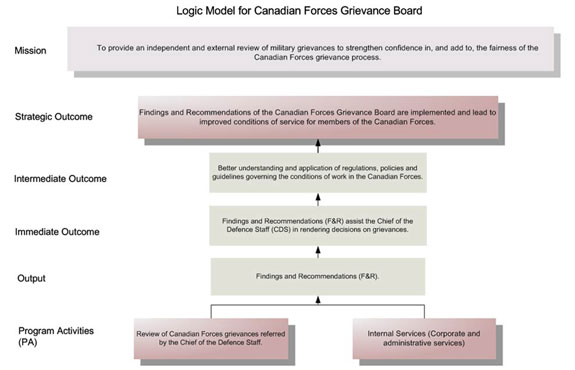ARCHIVED - Canadian Forces Grievance Board - Report
 This page has been archived.
This page has been archived.
Archived Content
Information identified as archived on the Web is for reference, research or recordkeeping purposes. It has not been altered or updated after the date of archiving. Web pages that are archived on the Web are not subject to the Government of Canada Web Standards. As per the Communications Policy of the Government of Canada, you can request alternate formats on the "Contact Us" page.
2009-10
Departmental Performance Report
Canadian Forces Grievance Board
The original version was signed by
The Honourable Peter G. MacKay
Minister of National Defence
Table of Contents
Section II – Analysis of Program Activities by Strategic Outcome
- Strategic Outcome
- Program Activities by Strategic Outcome
- Program Activity: Review of Canadian Forces grievances referred by the Chief of the Defence Staff
- Program Activity: Internal Services
Section III – Supplementary Information
Chairperson's Message

I am pleased to submit the Canadian Forces Grievance Board's Departmental Performance Report for the period ending March 31, 2010.
On June 15, 2010, the Board celebrated its tenth anniversary. During the months leading to this important milestone, the Board took the time to reflect on the lessons learned during its first decade of operations and to start setting the stage for the future.
In 2009-10, the Board restructured and refined its procedures to ensure a more integrated and efficient internal review process is in place. These adjustments allowed the Board to achieve the impressive results presented in this report.
As well, during the past year, in coordination with the Canadian Forces, the Board began evaluating a new model for the referral of grievances which we believe will further enhance the fairness and transparency of the military grievance system.
As an organization, we also strongly believe in the importance of sharing the knowledge we gain from the review of grievances. This is our way of contributing to an increased awareness and understanding of issues affecting Canadian Forces members. It is also an important contribution to the effectiveness of the military grievance process and the well-being and morale of Canadian Forces members.
With this in mind, we have recently started to publish the Board's recommendations we make to the Chief of the Defence Staff on systemic issues, in order to alert senior leadership, stakeholders, and key decision and policy makers to broader issues that come to our attention while reviewing individual grievances.
Throughout the year, our corporate initiatives have focused on providing the appropriate support to the organization, while ensuring our activities were consistent with the government's priorities and Public Service values and management excellence.
I am proud to say that the Canadian Forces Grievance Board has become a mature and well respected organization, not only within the specialized conflict resolution community but also as a small governmental agency recognized for its management excellence.
As our dedicated employees and Board members complete another year of hard work, I am confident that we have the right skills and the resolve to guide our organization towards the two components of our vision: to be a model administrative tribunal that functions with professionalism, good governance and fair processes, and to be the centre of expertise in military grievances.
Bruno Hamel
Chairperson
Section I – Overview
Summary Information
Raison d’Ítre
The raison d'Ítre of the Canadian Forces Grievance Board (CFGB or the Board) is to provide an independent and external review of military grievances. Section 29 of the National Defence Act (NDA) provides a statutory right for an officer or a non-commissioned member who has been aggrieved, to grieve a decision, an act or an omission in the administration of the affairs of the Canadian Forces (CF). The importance of this broad right cannot be overstated since it is, with certain narrow exceptions, the only formal complaint process available to CF members.
Responsibilities
The Board is an independent administrative tribunal reporting to Parliament through the Minister of National Defence.
The Board reviews grievances referred to it and provides findings and recommendations (F&Rs) to the Chief of the Defence Staff (CDS) and the officer or non-commissioned member who submitted the grievance.
The Board also has the obligation to deal with all matters before it as informally and expeditiously as the circumstances and the considerations of fairness permit.
Strategic Outcome and Program Activity Architecture (PAA)
Figure 1
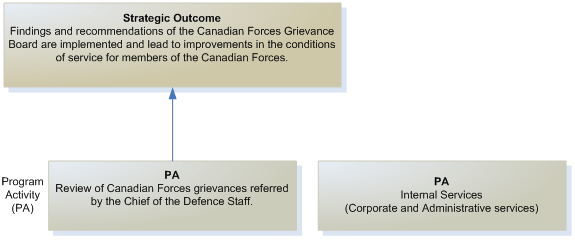
Summary of Performance
2009-10 Financial Resources ($ thousands)
| Planned Spending | Total Authorities | Actual Spending |
|---|---|---|
| 6,458.0 | 7,177.3 | 5,664.9 |
2009-10 Human Resources (FTEs)
| Planned | Actual | Difference |
|---|---|---|
| 46 | 35 | 11 |
The variance in Full-time Equivalents (FTEs) from 46 to 35 is primarily due to delays in the staffing of positions.
| Strategic Outcome: Findings and Recommendations of the Canadian Forces Grievance Board are implemented and lead to improved conditions of service for members of the Canadian Forces. | ||
|---|---|---|
| Performance Indicators | Targets | 2009-10 Performance |
| The percentage of recommendations on systemic issues that merit further action. | 75% of recommendations are accepted by the Chief of the Defence Staff. | Just over 20 recommendations on systemic issues are communicated annually and in the last five fiscal years, the Chief of the Defence Staff accepted 71.2% recommendations on systemic issues that merited further action. |
| The percentage of the Chief of the Defence Staff agreement with the Board's recommendations on systemic issues regarding the interpretation of regulations, policies or guidelines. | 80% agreement | A number of CDS decisions are still pending for 2009-10 cases. However, between 2005-06 and 2008-09 the CDS agreed with the Board on 76.6% of its recommendations. |
| The percentage of survey respondents indicating that the Board has contributed to changes to Canadian Forces regulations, policies and procedures. | 70% agreement | This performance indicator was assessed through a formal evaluation conducted in 2009-10. Preliminary findings of the evaluation show no clear evidence that the CFGB's work led to improvements to regulations, policies and procedure, although, perceptions are that it has. Just over half of the respondents surveyed agreed that the work of the CFGB had led to improvements. |
| ($ thousands) | ||||||
|---|---|---|---|---|---|---|
| Program Activity | 2008-09 Actual Spending |
2009-10 | Alignment to Government of Canada Outcomes | |||
| Main Estimates |
Planned Spending |
Total Authorities |
Actual Spending |
|||
| Review of Canadian Forces grievances referred by the Chief of the Defence Staff | 3,059.0 | 3,382.0 | 3,382.0 | 3,901.1 | 2,360.5 | |
| Internal Services | 2,976.0 | 3,076.0 | 3,076.0 | 3,276.2 | 3,304.4 | |
| Total | 6,035.0 | 6,458.0 | 6,458.0 | 7,177.3 | 5,664.9 | |
| Expected Results: Better understanding and application of regulations, policies and guidelines governing the conditions of work in the Canadian Forces. |
|---|
These expected results which flow from the Board's activities, outputs and immediate outcomes, and which demonstrate progress towards achieving its strategic outcome, are evident in the long term.
| Performance Indicator | Target |
|---|---|
| The percentage of recommendations on systemic issues that merit further study. | 75% of recommendations that merit further study are accepted by the Chief of the Defence Staff. |
The CDS has an increased awareness and understanding of systemic issues arising from grievances reviewed by the CFGB. Just over 20 recommendations on systemic issues are communicated annually and in the last five fiscal years, the CDS accepted 71.2% of the Board's recommendations on systemic issues that merited further action.
Over the same period, the CDS did not accept the recommendations in 22.7% of the cases and in 6.1% of the cases, while systemic issues were acknowledged, no action was taken by the CDS.
During the reporting period 2009-10, the Board made recommendations with respect to the following systemic issues (in alphabetical order):
- Accuracy of information given to applicants;
- Acting rank;
- Administration of Foreign Service Premium and Operations Foreign Service Premium;
- Administration of Imposed Restriction and Separation Expense;
- Boundaries of post living differential regions;
- CDS's authority to award financial award;
- Circumstances governed by more than one Policy;
- Compulsory retirement age;
- Entitlement to the daily rate of Class C pay on short-term Class C;
- Harassment complaints versus grievances for military members;
- Jurisdiction concerning time limits for submission of grievance;
- Operational status of sea training units;
- Post Living Differential for St-Hyacinthe;
- Recruitment allowance; and
- Sea Duty Allowance.
To promote awareness of these issues, beginning in July 2009, the Board started publishing its recommendations on systemic issues on its website. The Board intends to follow each recommendation until the CDS makes a decision. Furthermore, whenever a decision is made to act on a recommendation, the Board will monitor its progress.
| Performance Indicator | Target |
|---|---|
| The percentage of the Chief of the Defence Staff agreement with the Board's recommendations on systemic issues regarding the interpretation and application of regulations, policies and guidelines. | 80% agreement |
Out of the 109 recommendations on systemic issues made by the Board in the last five fiscal years, 72.4% concerned the interpretation and application of regulations, policies and guidelines. While a number of CDS decisions are pending for 2009-10 cases, between 2005-06 and 2008-09 the CDS agreed with the Board on 76.6% of these recommendations.
During the same period, the CDS did not accept the recommendations in 19.1% of the cases and in 4.3% of the cases, while systemic issues were acknowledged, no action was taken by the CDS.
| Performance Indicator | Target |
|---|---|
| The percentage of survey respondents indicating that the Board has contributed to changes to Canadian Forces regulations, policies and procedures. | 70% agreement |
Success regarding this performance indicator was assessed through a formal evaluation conducted in 2009-10.
Preliminary findings of the evaluation demonstrated no clear evidence that the CFGB's work led to improvements to regulations, policies and procedures, although, perceptions are that it has.
Just over half of the respondents surveyed in the CFGB evaluation agreed that the work of the CFGB had led to improvements. However, half of those who agreed noted it is difficult to attribute a policy change to any single factor or questioned whether the change would have occurred regardless of the CFGB's work. However, with regard to whether or not the CFGB has helped in the administration of affairs of the CF, 80% of interviewees agreed. They noted that the CFGB F&Rs raise awareness in areas where policy changes may be needed and help confirm interpretation of policies, allowing CF Initial Authorities (IA) to be more confident in their decisions. The CFGB website and publications also help IAs and potential grievors in deciding how to proceed when issues arise.
Contribution of Priorities to Strategic Outcomes
| Operational Priorities | Type | Status | Links to Strategic Outcome(s) |
|---|---|---|---|
|
Operational Performance Maintain steady-state productivity and excellence |
Ongoing | Met all | (PA) Review of Canadian Forces grievances referred by the Chief of the Defence Staff. |
|
External Communications Demonstrate the value-added of the CFGB in the grievance process. |
Ongoing | Met all | (PA) Review of Canadian Forces grievances referred by the Chief of the Defence Staff. (PA) Internal Services. |
| Management Priority | Type | Status | Links to Strategic Outcome |
|---|---|---|---|
|
Operational Performance Ensure the overall effective management and leadership of the CFGB |
Ongoing | Met all | (PA) Internal Services. |
Performance Status
Priority 1: Operational Performance - Maintain steady-state productivity and excellence
Productivity
Operational performance is a priority for the Board. It represents its ongoing contribution to the fairness and efficiency of the military grievance process and ensures the high quality and timeliness of its F&Rs. To maintain optimum productivity and the quality of its services, the Board regularly assess its internal review processes and closely monitors and evaluates its production timelines, workload and planning assumptions. This rigourous exercise allows the Board to react quickly to realign its resources to its workload.
In 2009, the Board restructured its operations by merging its grievance analysis and legal counsel directorates. Furthermore, in July 2009, the Board moved towards a more integrated internal review process, with the assigned Board member, team leader, grievance officer and legal counsel participating in a case conference in the initial stages of review. These changes resulted in significant savings in time and improved quality assurance of the Board's F&Rs.
Figure 2
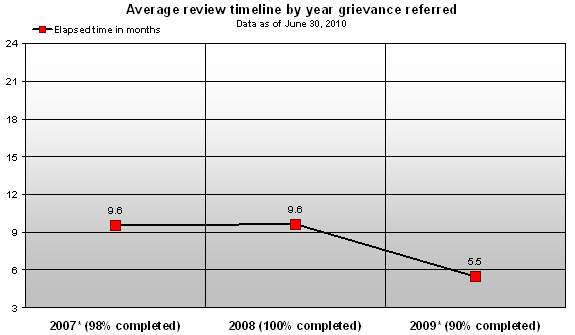
Notes*: The remaining case for 2007 is held in abeyance at the grievor's request. Not all cases received in 2009 have been completed to date. These statistics will be adjusted in future reports to include the balance of the cases received in 2009.
Figure 2 demonstrates the average elapsed time taken to complete cases received in the last three years.
Refinements implemented last year have further streamlined the process and increased efficiency, bringing the average down to 5.5 months for cases received in 2009 and completed as of the end of June 2010.
An Independent Review
As an administrative tribunal, the Board is always conscious of its fundamental obligation to review every case fairly and impartially. Each file is carefully reviewed, the issues analyzed and the relevant evidence considered, including submissions of the grievor and CF authorities. Each case is reviewed on its own merits; however the Board maintains an extensive database of precedent CDS decisions and F&R to assist Board members and staff in considering a file. Grievances usually involve decisions made by CF authorities; the Board's general approach is to examine both the evidence and the process to ensure the decision is both reasonable and correct.
"We wish to commend [Board Member] for the excellent and well-balanced analysis of the situation faced by our client and for the reasoned findings and recommendations he has made. Though the result is not fully in the favour of the client, we believe it is an acceptable conclusion to our client's grievance and we are pleased to acknowledge the professional manner with which
our client's grievance was reviewed by your Board."
Colonel (retired) Michel W. Drapeau, Legal Counsel.
Since 2005, the Board issued F&R on 605 grievances of which 42.5% (257 cases) had recommendations to uphold or partially uphold the grievance. The CDS has so far rendered decisions on 210 of these 257 cases. Figure 3 sets out the number of cases for the past five years where the Board has recommended denial or grant.
Figure 3
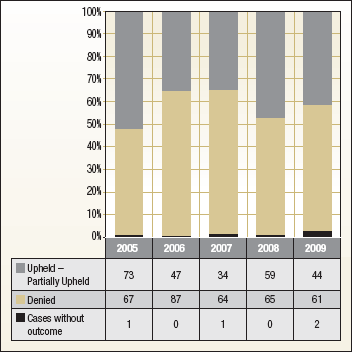
Excellence
In the last five years, as shown in Figure 4, of the 210 cases where the Board recommended upholding the grievance and for which the CDS rendered decisions, the CDS agreed with the Board in 81% of the files. This result demonstrates the value of the Board's independent and expert review. In cases where the recommendations was to deny the grievance, the Board's F&R provided the grievor with a detailed explanation of the Board's conclusions and the basis upon which the review validated the CF's interpretation of the regulation, policy or order in question.
Figure 4
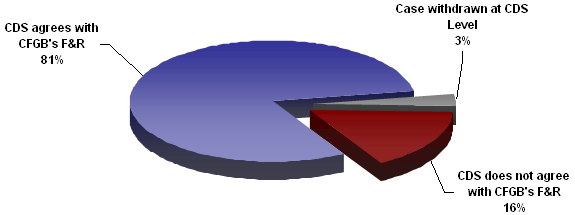
Priority 2: External communications – Demonstrate the value-added of the CFGB in the grievance review process
Sharing Lessons Learned
The Board increased and diversified its communications tools and engaged all levels of stakeholders within the CF through publications, base visits, regular meetings, presentations in a variety of venues. Base visits provide CF members with an opportunity to directly exchange information about issues and concerns related to complaint resolution and to learn about the Board's work and procedures. They also allow Board personnel to better understand the CF unique environment.
Sharing information with the CF members about cases reviewed by the Board can improve their understanding of the regulations, policies and guidelines affecting them. In order to reach out to CF members, the Board published two Bulletins inserted in the Maple Leaf, the weekly national newspaper of the Department of National Defence (DND) and the CF.
The Board also published a second edition of Perspectives, a newsletter directed primarily to senior CF officials at DND Headquarters. Through the review of individual grievances, the Board is able to identify general trends, conflicting or inadequate policies, areas of dissatisfaction and problems of a systemic nature.
As well, the Board recently started to publish the recommendations made to the Chief of the Defence Staff on systemic issues, in order to alert senior leadership, stakeholders and key decision makers to broader issues that come to the Board's attention while reviewing grievances.
The quarterly eBulletin, which is available on the CFGB website, has proven to be a valuable communication tool. Along with case summaries of the last three years, it highlights current and interesting cases reviewed by the Board and describes the Board's F&R and the final CDS decision for each case. The Board's website is updated regularly and case summaries,
recommendations on systemic issues and other related information are posted as they become available. ![]() http://www.cfgb-cgfc.gc.ca/English/PandR.html
http://www.cfgb-cgfc.gc.ca/English/PandR.html
A New Model for Grievance Referrals
Current regulations stipulate that only certain categories of grievances are referred to the Board for review. Therefore, not every grievor whose grievance has reached the Final Authority (FA) level benefits from the Board's external review of his or her complaint. In 2009, the CFGB, in coordination with the CF, began evaluating a new model for the referral of grievances, which the Board believes will add to the fairness and transparency of the military grievance process.
Under this new ‘principled approach' to grievance referrals, the Board would review all grievances where the CF is unable to resolve the matter to the satisfaction of the grievor. In those cases, the CDS and the CF member would benefit from the Board's independent review before a final decision is rendered. The CDS supported the ‘principled approach' initiative in his 2008 Annual Report on the Canadian Forces Grievance System. Amendments to the NDA and regulations may be required to fully implement this initiative.
"Your superior knowledge of policies pertinent to my case enabled you to point out numerous administration actions that contravened published directives. This resulted in a favourable outcome for me. I hope this won't happen to another Reservist in the future."
A member of the Reserve Force praising the Canadian Forces Grievance Board's work after he was granted redress.
Figure 5 shows the breakdown, by category, of the grievances received at the Board in the last three years (financial, general, harassment/discrimination and release). In 2009, grievances related to financial issues continued to be in the majority.
Figure 5
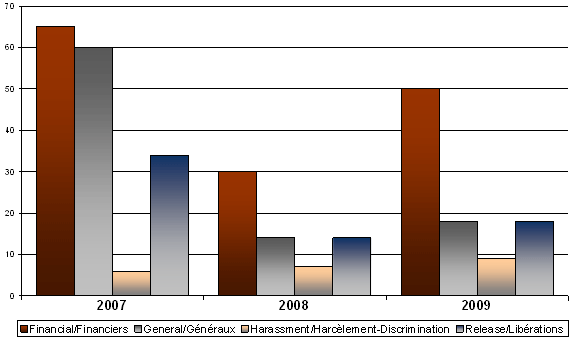
The table below outlines the distribution by recommended outcome of the 114 cases completed by the Board in 2009-10.
| Grievance Categories | Upheld | Partially Upheld | Denied | Not Grievable | Total |
|---|---|---|---|---|---|
| Financial | 18 | 7 | 26 | 51 | |
| General | 5 | 7 | 17 | 1 | 30 |
| Harassment-Discrimination | 1 | 3 | 6 | 10 | |
| Release | 6 | 1 | 16 | 23 | |
| Total | 30 | 18 | 65 | 1 | 114 |
A Centre of Expertise
The Board developed a unique expertise in the review of military grievances and gained recognition for its contribution to the fairness and transparency of complaint resolution within the CF. Recently, the Vice Chief of the Defense Staff invited the Board to participate in a high level working group tasked to review and streamline the Canadian Forces military grievance process. The Board was pleased to have the opportunity to contribute to these important discussions.
As well, the Board was asked to participate at different CF conferences and events such as the Chief Warrant Officers and the Chief Petty Officers 1st Class Qualification Courses, in April and September 2009, and at the Director General Military Careers Symposium in October 2009.
Priority 3: Operational Performance – Ensure the overall effective management and leadership of the CFGB
Throughout the past year, the CFGB focused on ensuring that the Board's management initiatives were well aligned with the Public Service Renewal priorities, as well as the priorities outlined in the Clerk of the Privy Council's Sixteenth Annual Report to the Prime Minister on Public Service of Canada. The Board also used the Management Accountability Framework (MAF), the government's own blueprint for sound management, as the foundation for its operational and strategic planning, with a particular emphasis on the five-year evaluation of the Board's performance; the work environment; enhancing Information Management/Information Technology (IM/IT) infrastructure; and reviewing and updating IM/IT and Human Resources policies.
Five-year evaluation of Board performance
All departments and agencies are required to conduct a comprehensive review of their programs every five years. In compliance with this requirement, in 2009-10, the Board launched a new evaluation to assess its performance. This evaluation provides the Board with valuable feedback which will help to position it for the future. The scope of the evaluation is restricted to CFGB services that directly benefit the CF and its members. The evaluation will be completed in 2010-11 and the report will be posted on the Board's website.
Acting on Public Service Renewal Priorities
Integrated Planning: The Board continued to put a strong emphasis on linking human resource needs with the organization's business needs. It further enhanced its planning and reporting instruments and streamlined its processes.
Recruitment: One of the priorities identified in the Public Service Renewal Action Plan is to close the gap in the representation of designated employment equity groups, particularly visible minorities, within the Public Service. Acting on this priority, the Board developed and implemented new staffing strategies and, by December 31, 2009, succeeded in doubling the representation of visible minorities within its staff from 2.5% in the previous year to 5.4%. The Board also increased its representation of the three other designated employment equity groups.
Employee Development: As stated in the Sixteenth Annual Report to the Prime Minister on the Public Service of Canada, the Clerk of the Privy Council identified as a priority the promotion of Canada's linguistic duality in the Public Service. The Board is committed to maintaining a workplace where employees can use their official language of choice, while supporting and encouraging those who develop skills in the second official language. Training was offered to employees and an Official Languages workshop was organized for all staff.
Enabling Infrastructure: In 2009-10 the Board conducted a review of the suite of IT, IM and HR policies. As a result, the Board updated and revised all IT Security policies and documentation. Some of the instruments included CFGB IT Security Directives, the CFGB IT Security Program Requirement and Documentation Framework, the CFGB IT Security Governance Model and the global CFGB IT Security Policy.
With regard to Human Resources, Occupational Health and Safety (OHS) policies and the Learning policies were reviewed. The review of the OHS policies led to revamping the CFGB OHS program, the creation of the website for employee consultation and mandatory OHS training for all staff.
Risk Analysis
Some key factors beyond the direct control of the Board can influence the realisation of its main objectives. One significant factor is that the Board has no control over the number of grievances referred in any given year. Significant fluctuations on the number of grievances referred could have an impact on the Board's capacity to issue timely F&Rs on grievances. As well, the Board faces several key HR and information management and informatics challenges. As shown below, the Board identified four key risks and associated mitigation strategies for attention in 2009-10.
| Risk Ref | Key Corporate Risk / Opportunity | Risk Definition and Mitigation Measures | CFGB Risk Score (High, Medium, Low) |
|---|---|---|---|
| 4 | Significant fluctuations in volume of grievances received |
There is a risk that the CFGB will be unable to respond in a timely manner to the demand of a sudden and significant influx of grievances. Similarly, there is a risk that the CFGB will be overly resourced should the volume of grievances drop off significantly.
|
Medium |
| 2 | The raison d'Ítre of the CFGB is questioned |
There is a risk that the CFGB will be perceived as not adding value to the grievance process.
|
Medium |
| 3 | HR capacity and competencies |
There is a risk that the CFGB will not have the appropriate staff to complete its mandate (number and competencies).
|
Medium |
| 1 | Corporate Knowledge Management |
There is a risk that the integrity and completeness of information and knowledge of the organization may be compromised or lost.
|
Medium |
Expenditure Profile
CFGB's actual spending for 2009-10 was $5.7 million. Over the past three years actual spending has decreased by 9% from 2007-08 levels. This decrease was primarily due to delays in the staffing of positions. The chart at Figure 6 shows the Board's spending trend over a six-year period (three-year actual spending and three-year planned spending).
Figure 6
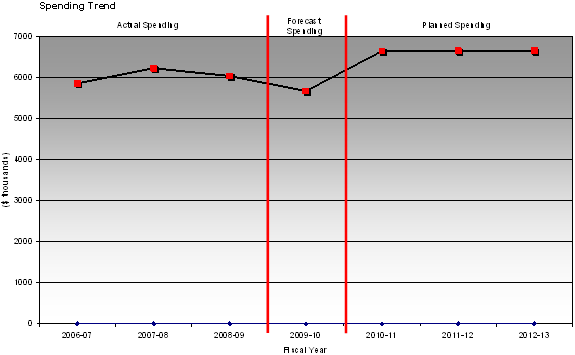
Voted and Statutory Items
This table illustrates the voted items Parliament approved through the Main Estimates. The statutory items are displayed for information purposes only.
| Vote # or Statutory Item (S) | Truncated Vote or Statutory Wording | 2007-08 | 2008-09 | 2009-10 | |
|---|---|---|---|---|---|
| Actual Spending | Actual Spending | Main Estimates | Actual Spending | ||
| 15 | Operating expenditures | 5,605.0 | 5,490.0 | 5,897.0 | 5,094.5 |
| (S) | Contributions to employee benefit plans | 617.0 | 545.0 | 561.0 | 570.4 |
| Total | 6,222.0 | 6,035.0 | 6,458.0 | 5,664.9 | |
Section II – Analysis of Program Activities by Strategic Outcome
Strategic Outcome - Findings and Recommendations of the Canadian Forces Grievance Board are implemented and lead to improvements in the conditions of service for members of the Canadian Forces.
The Board conducts objective and transparent reviews of grievances with due respect to fairness and equity for each member of the CF, regardless of rank or position. It ensures that the rights of military personnel are considered fairly throughout the process and is committed that its Board Members act in the best interest of the parties concerned. The findings and recommendations issued by the Board are based in fact and law and may establish precedents that can facilitate needed change within the CF. Complaints can be indicators of broad or systemic issues that may offer useful information to prevent problems or to improve policies or procedures. The Board's Logic Model, at Figure 7, illustrates how each of the items contributes to the fulfillment of the Board's mission and the achievement of its strategic outcome.
(click on image to enlarge)
Program Activities by Strategic Outcome
| Expected Results |
Performance Indicators |
Targets | Performance Status |
Performance Summary |
|---|---|---|---|---|
| Fair, impartial and transparent Findings and Recommendations. | % of survey responses from grievors satisfied with the fairness, impartiality and transparency of the Board's Findings and Recommendations | 75% in agreement | Mostly met | 79.6% agreed or strongly agreed that they were provided with appropriate disclosure of information and 68.4% agreed or strongly agreed that their grievance had been reviewed in a fair and unbiased manner. |
| Findings and Recommendations delivered expeditiously. | % of CFGB's grievance process timeline standards met | Established standards are being met 75% of the time | Mostly met | To date of the 2009 cases received 90% were completed out of which 62.7% were completed within the 6 months standard. |
| Closure rate of disposition of cases over a 3 year average | 1:1 closure rate | Exceeded | 1.23 |
Performance Analysis:
Feedback from Grievors
In 2005 the Board implemented a mail survey which was designed to seek anonymous feedback from grievors. The information gathered is evaluated on an ongoing basis so the Board can assess the feedback and take appropriate action as required.
For the five-year period covered by the program evaluation conducted in 2009-10, 16% of the grievors responded to the survey. The survey found that respondents were generally satisfied with the Board's procedures and analysis, as 79.6% agreed or strongly agreed that the CFGB disclosure process was fair. Similarly they are satisfied with equity and transparency, as 68.4% agreed or strongly agreed that their grievance had been reviewed in a fair and unbiased manner. Less than half (49.5%) agreed that their grievance was handled in a timely manner; however, it would appear the majority of respondents referred to the timeliness of the entire grievance process and not the Board's review.
A Timely Review
The Board established an average productivity standard of six months to complete the review of a grievance. Refinements implemented during the last year have further streamlined processes and increased efficiency, bringing the average time to complete a case down to 5.5 months for cases received in 2009 and completed as of the end of June 2010. With more than 90% of those 2009 cases completed, results have surpassed expectation.
| Elapsed completion time |
Year Referred to CFGB | ||
|---|---|---|---|
| 2007 | 2008 | 2009 | |
| Less than 6 months | 21.5% | 38.5% | 62.7% |
| 6 months to 1 year | 54.0% | 29.2% | 34.9% |
| More than 1 year | 24.5% | 32.3% | 2.4% |
| Total Completed | 98*% | 100% | 90*% |
Notes*: The only remaining case for 2007 is held in abeyance at the grievor's request. Not all cases received in 2009 have been completed to date. These statistics will be adjusted in future reports to include the balance of the cases received in 2009.
1:1 closure rate
The number of completed versus received cases over a 3 year period resulted in a 1.23 average closure rate. The increased efficiency is better than expected, considering that 75% of the cases received in 2009 were categorized as complex and dealt with multiple issues. The improved timeliness has also resulted in a significant decrease in the inventory of grievances where most of the remaining cases older than one year are either in abeyance or pending the receipt of supplementary information.
Lessons Learned
The CFGB constantly monitors its processes and structure to ensure file review is both timely and rigorous. The merging of the operations directorate and the legal section increased group cohesion and improved efficiency. As well, following last year's introduction of a case conference at an earlier stage in the process, the Board decided to include the assigned Board member with the assigned team leader, grievance officer and legal counsel. This has allowed for the identification of key issues and concerns at the beginning of the review process thereby saving significant time.
A number of factors have an impact upon the time it takes to produce F&Rs. These include the number of cases received by the Board and their complexity. The Board has no control over these factors and can only ensure that appropriate internal mechanisms are in place for producing F&Rs within a reasonable time frame.
Benefits for Canadians
The effectiveness of the administration of the affairs of the CF is enhanced by the CFGB external review of military grievances in accordance with the government values of equity, transparency & fairness. The Board is committed to maximizing its contribution to the military grievance process and, thereby, the well-being and morale of CF members.
"The Board is key to the Canadian Forces complaint resolution system... The expectation of a fair treatment in respect of a complaint is an underlying part of morale and Esprit de Corps... Thank you for serving the men and women who serve in Canada and abroad."
The Chief of the Defence Staff, General Walter Natynczyk, during a visit to the Canadian Forces Grievance Board offices in September 2009.
Internal services support a common government-wide approach to planning, designing, budgeting, reporting and communicating.
Performance Analysis
Strengthening the Board's governance and corporate management
To strengthen internal information management, the Board put in place an Information Management Working Group which provides overall direction and leadership to the various sectors when dealing with practical issues associated with Information Management (IM).
The Board developed the CFGB Security Handbook, which provides guidelines on the classification of documents and the storage, transmittal and transportation of documentation to ensure that the integrity and completeness of information within the organization is not compromised or lost and to ensure the highest possible security standards.
As well, to increase employee awareness, the CFGB Security Handbook further delineates the roles and responsibilities of each employee on all other aspects of IT Security.
The Board also commenced a comprehensive review and update of its Business Continuity and Resumption Plan, to guide activities should a crisis disrupt normal work routines, this review will be completed in 2010-11. Also, as a result of its risk analysis, the Board started scanning the hard copy of the case files to ensure that no information is lost and to provide part-time Board members with quicker remote access to the case file.
Public Service Renewal Action Plan
In support of the priorities established in the Public Service Renewal Action Plan, the Board included employment equity goals and objectives in all corporate planning documents.
The Board continued to improve on its integrated business and human resources plans, through expansion of the identification of risk and risk mitigation strategies to address challenges and gaps in its human resources capacity.
Lessons Learned
Enhancements to the Board's information management planning activities not only support the objectives of information management policies, but facilitate managing information in support of decision making, and ensure compliance with the Policy on information Management and knowledge management.
An integrated planning process supports decision-making and the achievement of corporate objectives, through the alignment of the Board's resources with its priorities.
Benefits to Canadians
Internal services establish the framework to ensure the Board is well managed, to promote management excellence and to ensure the sound stewardship of resources. Efficient and effective internal services are essential to meet management and financial performance expectations.
Section III – Supplementary Information
Financial Highlights
The financial highlights presented within this DPR are intended to serve as a general overview of CFGB's financial position and operations.
| Condensed Statement of Financial Position At the end of Fiscal Year (March 31, 2010) |
% Change | 2008-09 | 2009-10 | |
|---|---|---|---|---|
| Assets | Total Assets | 53.0% | 272 | 178 |
| Liabilities | Total Liabilities | 5.7% | 1,411 | 1,334 |
| Equity | Total Equity | -1.0% | (1,139) | (1,156) |
| Total | 53.0% | 178 | 272 | |
| Condensed Statement of Operations At the end of Fiscal Year (March 31, 2010) |
% Change | 2008-09 | 2009-10 | |
|---|---|---|---|---|
| Expenses | Total Expenses | -3.0% | 6,159 | 5,972 |
| Revenues | Total Revenues | - | - | - |
| Net cost of operations | -3.0% | 6,159 | 5,972 | |
CFGB invested a significant sum in 2009-10 to purchase videoconferencing equipment, therefore increasing its assets by 53%.
Financial Statements
The Board's financial statements can be found on the CFGB's website at:
![]() http://www.cfgb-cgfc.gc.ca/
http://www.cfgb-cgfc.gc.ca/
List of Tables
The following electronic table is located on the Treasury Board Secretariat website at the following address: ![]() http://www.tbs-sct.gc.ca/dpr-rmr/st-ts-eng.asp
http://www.tbs-sct.gc.ca/dpr-rmr/st-ts-eng.asp
- Evaluations
Other Items of Interest
Contacts for further information
Telephone:
1-877-276-4193 [Toll free]
(613) 996-8529
Facsimile:
1-866-716-6601 [Toll free]
(613) 996-6491
E-mail
cfgb-cgfc@cfgb-cgfc.gc.ca
Visit the Board's Web site at ![]() http://www.cfgb-cgfc.gc.ca for more information about its work, case summaries, and other additional reports.
http://www.cfgb-cgfc.gc.ca for more information about its work, case summaries, and other additional reports.
